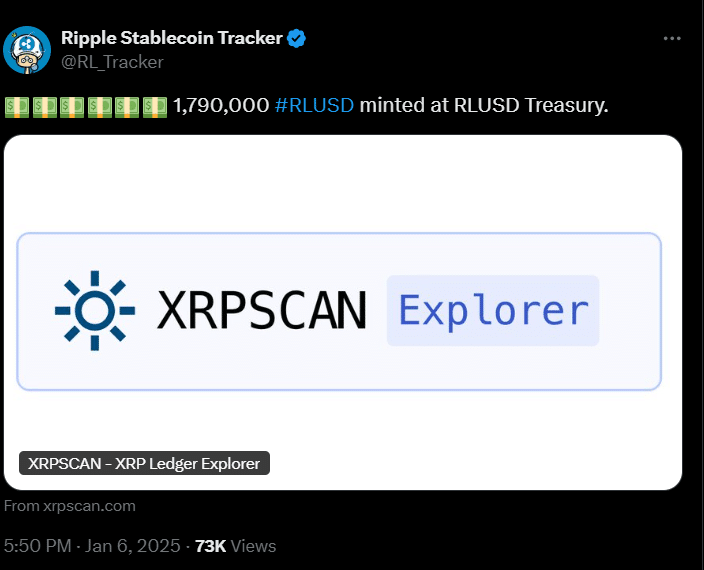Ripple’s strategic focus on stablecoins is a significant part of its vision to bridge traditional finance with blockchain technology, aiming to establish the XRP Ledger (XRPL) as a leading platform for institutional digital finance. This involves not only launching its own stablecoin but also fostering a robust ecosystem for other fiat-backed digital currencies.
Ripple USD Stablecoin: RLUSD
Ripple has launched its institutional-grade stablecoin, RLUSD, a pivotal element in its strategy to facilitate seamless digital asset transactions for regulated entities.
What is RLUSD?
RLUSD is designed to maintain a fixed 1:1 value with the U.S. Dollar, offering a stable digital representation of dollar-denominated assets. It is initially minted on both the XRP Ledger and Ethereum blockchains, ensuring broad accessibility.
A key differentiator for RLUSD is its robust regulatory oversight by the New York Department of Financial Services (NYDFS), a highly respected regulator known for its strict standards.
This regulation mandates transparent reserve attestations, providing a high level of assurance and trust for institutional users. The stablecoin’s value is underpinned by a carefully managed portfolio of real-world, low-risk, and liquid assets. This is encompassing U.S. dollar deposits, short-term U.S. treasuries, and cash equivalents. This comprehensive backing ensures its reliable and direct redeemability for physical dollars.
For more: XRP Deep Dive: A Comprehensive Analysis of Ripple Effect


Source: Ripple
RLUSD Performance and Efficiency
RLUSD transactions are characterized by exceptional speed, typically confirming within 3-5 seconds, and incur ultra-low fees, approximately $0.0002 per transaction. The stablecoin also boasts high scalability, capable of processing over 1,500 transactions per second. This efficiency is crucial for high-volume institutional use cases.
RLUSD Use Cases and Market Presence
RLUSD is optimized for a variety of critical functions within the digital finance ecosystem:
- Cross-Border Payments: It provides reliable access to digital dollars for global value transfer, enhancing the efficiency of Ripple’s existing payment network, which serves hundreds of institutional customers across over 50 countries.
- Everyday Transactions: RLUSD offers a stable and reliable method for daily transactions, serving as an alternative to traditional cash or cards.
- On/Off-Ramping: For institutions, RLUSD simplifies the process of converting fiat to crypto (on-ramping) and vice-versa (off-ramping), acting as a trusted entry point into blockchain technology.
- Collateral and DeFi Integrations: It can be used as collateral for tokenized assets on the XRPL and integrated into various Decentralized Finance (DeFi) applications on both XRPL and Ethereum for trading, yield farming, staking, and loans.


Ripple mints 1.79 million RLUSD tokens
As of recent data, RLUSD recorded a volume of $500 million in Q2 and holds a market capitalization of approximately $294 million. Notably, a significant surge occurred in January, with RLUSD experiencing a remarkable 2000% growth in trading volume, indicating rapid adoption and increasing market activity.
The $400,000,000 trading volume on the RLUSD/USD pair at Bullish is too high imo. Can you shed more light on the stats on your exchange @Bullish ?
The orderbooks are thin too. pic.twitter.com/820I42Ps32
— Vet (@Vet_X0) January 4, 2025
XRPL as a Growing Stablecoin Hub
Beyond its proprietary RLUSD, Ripple is actively cultivating the XRP Ledger into a vibrant hub for a diverse range of fiat-backed stablecoins, attracting various issuers due to its unique architecture and capabilities.
Diverse Stablecoin Offerings
The XRPL is witnessing a growing influx of fiat-backed stablecoins. Notably, USDC, issued by Circle, has debuted on the XRP Ledger, significantly expanding its utility across decentralized finance and cross-border payments.
This integration provides developers, institutions, and users direct access to the second-largest dollar-pegged stablecoin on Ripple’s layer-1 network. Other stablecoins now live on the XRPL include XSGD (Singapore dollar-backed by Straitsx) and EURØP (euro-denominated by Schuman Financial).
🚨BREAKING: StraitsX Launches Its Singapore-Dollar Pegged Stablecoin, $XSGD, on #XRP Ledger!
💥IT’S HAPPENING FOLKS!💥 pic.twitter.com/hVnEXDFQ88
— JackTheRippler ©️ (@RippleXrpie) May 19, 2025
“Compliance-First Architecture”
A key factor attracting stablecoin issuers to the XRPL is its inherent “compliance-first architecture”. This design philosophy prioritizes regulatory adherence, making it highly appealing for issuers seeking scalable infrastructure that meets real-world utility and regulatory requirements.
Technical Integration Mechanisms
The XRPL offers several technical features that facilitate seamless stablecoin integration and functionality:
- XRP as a Bridge Asset: As the XRP Ledger’s native digital asset, XRP plays a vital role. It powers fast settlement and ensures efficient liquidity for cross-currency transactions by acting as a bridge. The XRPL’s integrated decentralized exchange (DEX) further leverages XRP, notably through an automatic bridging feature that streamlines stablecoin transfers.
- Trust Lines: The XRPL utilizes “trust lines,” which are structures for holding tokens. These enforce rules to prevent unwanted token holdings and allow issuers to set limits for stablecoin transfers.
- Authorized Trust Lines: This feature enables issuers to create tokens that can only be held by accounts they specifically authorize, enhancing control and compliance for regulated assets.
- Clawback Feature: An optional feature allows issuers to reclaim misused assets, such as stolen funds, providing an additional layer of security and control crucial for institutional use cases.
- Automated Market Makers (AMMs): The XRPL’s DEX includes AMMs, which are smart contracts that provide liquidity for token swaps, further enhancing the stablecoin trading environment.
Ripple Stablecoin: Strategic Importance and Future Outlook
The expansion of the stablecoin ecosystem on the XRP Ledger sits central to Ripple’s broader vision. This strategic move targets institutional digital finance. By offering regulated, transparent, and institutionally friendly stablecoin solutions, Ripple aims to accelerate adoption. This includes banks, fintech firms, and institutional investors. Notably, major financial institutions like Bank of America (BofA) have already shown heightened interest in Ripple’s stablecoin project. This indicates significant potential for future volume if fully adopted. Ultimately, this focus differentiates Ripple in a crowded market.
Aligning with Ripple’s 2025 Roadmap
Furthermore, this initiative aligns perfectly with Ripple’s ambitious 2025 roadmap. That plan focuses on building a comprehensive institutional DeFi ecosystem on the XRP Ledger. Plans include integrating RLUSD and real-world assets (RWAs) into institutional lending options. This supports a more mature and stable DeFi environment. Consequently, this strategic pivot aims to capture a broader segment of the financial market. It caters to the sophisticated needs of regulated institutions, offering tools for capital management, asset tokenization, and compliant DeFi participation.
Fueling Cross-Border Payments
Stablecoins are crucial for Ripple’s long-term goal. They aim to transform cross-border payments. By providing stable digital representations of fiat currencies, they enhance efficiency and reduce friction in Ripple’s payment network. In fact, Ripple’s CEO, Brad Garlinghouse, has articulated an ambitious vision. He believes XRP can capture a significant share of SWIFT’s cross-border payment volume. He reportedly stated that XRP could account for 14% of SWIFT’s total transaction volume within five years. Therefore, broader stablecoin adoption is essential to fuel these global payment ambitions. It provides the necessary liquidity and stability for large-scale international transfers.
Competitive Advantage Through Compliance
Ripple’s strategic emphasis on regulatory compliance provides a significant competitive advantage. This is clearly demonstrated by RLUSD’s NYDFS regulation and the XRPL’s “compliance-first architecture.” Moreover, this proactive approach to regulation allows Ripple to bridge the gap between legacy systems and blockchain technology more effectively than many competitors. It positions Ripple as an enabler of modernization rather than a pure disruptor. Ultimately, this pragmatic choice makes Ripple’s solutions inherently more appealing and adaptable for traditional financial institutions operating within stringent regulatory frameworks.
For more: Trading with Free Crypto Signals in Evening Trader Channel
 Bitcoin
Bitcoin  Ethereum
Ethereum  Tether
Tether  XRP
XRP  USDC
USDC  TRON
TRON  Lido Staked Ether
Lido Staked Ether  Dogecoin
Dogecoin  Figure Heloc
Figure Heloc  Cardano
Cardano  WhiteBIT Coin
WhiteBIT Coin  Bitcoin Cash
Bitcoin Cash  Wrapped stETH
Wrapped stETH  Wrapped Bitcoin
Wrapped Bitcoin  USDS
USDS  Wrapped eETH
Wrapped eETH  Binance Bridged USDT (BNB Smart Chain)
Binance Bridged USDT (BNB Smart Chain)  Chainlink
Chainlink  Monero
Monero  LEO Token
LEO Token  WETH
WETH  Zcash
Zcash  Stellar
Stellar  Hyperliquid
Hyperliquid  Ethena USDe
Ethena USDe  Coinbase Wrapped BTC
Coinbase Wrapped BTC  Litecoin
Litecoin  Sui
Sui  Avalanche
Avalanche  Hedera
Hedera  sUSDS
sUSDS  Shiba Inu
Shiba Inu  USDT0
USDT0  Dai
Dai  Uniswap
Uniswap  PayPal USD
PayPal USD  Canton
Canton  Mantle
Mantle  Cronos
Cronos  World Liberty Financial
World Liberty Financial  Toncoin
Toncoin  Ethena Staked USDe
Ethena Staked USDe  Polkadot
Polkadot  USD1
USD1  Aave
Aave  Rain
Rain  Bitget Token
Bitget Token  MemeCore
MemeCore 


